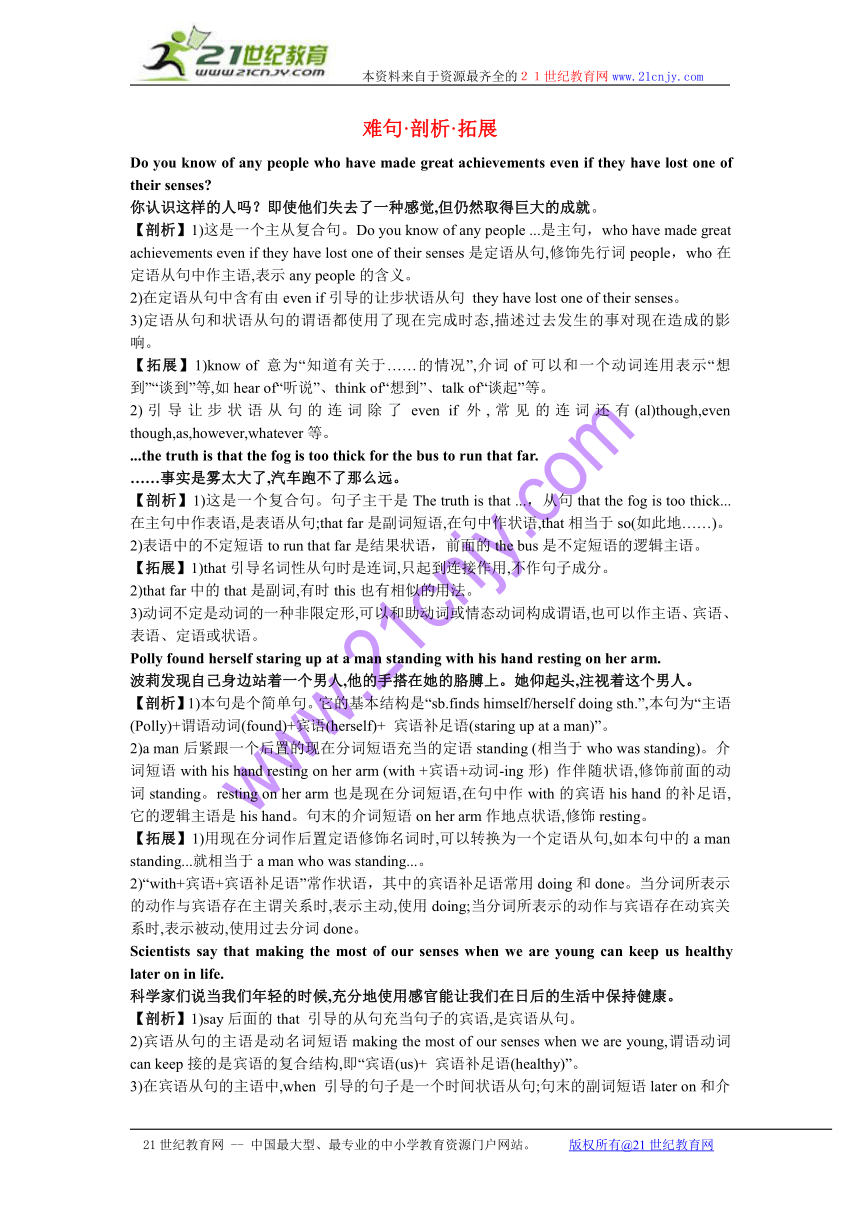unit 1 the world of our senses 难句剖析拓展
文档属性
| 名称 | unit 1 the world of our senses 难句剖析拓展 |  | |
| 格式 | rar | ||
| 文件大小 | 13.8KB | ||
| 资源类型 | 教案 | ||
| 版本资源 | 牛津译林版 | ||
| 科目 | 英语 | ||
| 更新时间 | 2010-12-18 22:52:00 | ||
图片预览

文档简介
本资料来自于资源最齐全的21世纪教育网www.21cnjy.com
难句·剖析·拓展
Do you know of any people who have made great achievements even if they have lost one of their senses
你认识这样的人吗?即使他们失去了一种感觉,但仍然取得巨大的成就。
【剖析】1)这是一个主从复合句。Do you know of any people ...是主句,who have made great achievements even if they have lost one of their senses是定语从句,修饰先行词people,who在定语从句中作主语,表示any people的含义。
2)在定语从句中含有由even if引导的让步状语从句 they have lost one of their senses。
3)定语从句和状语从句的谓语都使用了现在完成时态,描述过去发生的事对现在造成的影响。
【拓展】1)know of 意为“知道有关于……的情况”,介词of可以和一个动词连用表示“想到”“谈到”等,如hear of“听说”、think of“想到”、talk of“谈起”等。
2)引导让步状语从句的连词除了even if外,常见的连词还有(al)though,even though,as,however,whatever等。
...the truth is that the fog is too thick for the bus to run that far.
……事实是雾太大了,汽车跑不了那么远。
【剖析】1)这是一个复合句。句子主干是The truth is that ...,从句that the fog is too thick...在主句中作表语,是表语从句;that far是副词短语,在句中作状语,that相当于so(如此地……)。
2)表语中的不定短语to run that far是结果状语,前面的the bus是不定短语的逻辑主语。
【拓展】1)that引导名词性从句时是连词,只起到连接作用,不作句子成分。
2)that far中的that是副词,有时this也有相似的用法。
3)动词不定是动词的一种非限定形,可以和助动词或情态动词构成谓语,也可以作主语、宾语、表语、定语或状语。
Polly found herself staring up at a man standing with his hand resting on her arm.
波莉发现自己身边站着一个男人,他的手搭在她的胳膊上。她仰起头,注视着这个男人。
【剖析】1)本句是个简单句。它的基本结构是“sb.finds himself/herself doing sth.”,本句为“主语(Polly)+谓语动词(found)+宾语(herself)+ 宾语补足语(staring up at a man)”。
2)a man后紧跟一个后置的现在分词短语充当的定语standing (相当于who was standing)。介词短语with his hand resting on her arm (with +宾语+动词-ing形) 作伴随状语,修饰前面的动词standing。resting on her arm也是现在分词短语,在句中作with的宾语his hand的补足语,它的逻辑主语是his hand。句末的介词短语on her arm作地点状语,修饰resting。
【拓展】1)用现在分词作后置定语修饰名词时,可以转换为一个定语从句,如本句中的a man standing...就相当于a man who was standing...。
2)“with+宾语+宾语补足语”常作状语,其中的宾语补足语常用doing和done。当分词所表示的动作与宾语存在主谓关系时,表示主动,使用doing;当分词所表示的动作与宾语存在动宾关系时,表示被动,使用过去分词done。
Scientists say that making the most of our senses when we are young can keep us healthy later on in life.
科学家们说当我们年轻的时候,充分地使用感官能让我们在日后的生活中保持健康。
【剖析】1)say后面的that 引导的从句充当句子的宾语,是宾语从句。
2)宾语从句的主语是动名词短语making the most of our senses when we are young,谓语动词can keep接的是宾语的复合结构,即“宾语(us)+ 宾语补足语(healthy)”。
3)在宾语从句的主语中,when 引导的句子是一个时间状语从句;句末的副词短语later on和介词短语in life都是状语。
【拓展】1)make the most of 是“充分利用”的意思,它的同义短语有make the best of,make full use of。
2)动名词短语在句中相当于一个名词,可作主语、表语、宾语或介词的宾语。
I felt so tired that I couldn’t help wondering whether or not I could get to my destination.
我太累了,不禁怀疑是否能到达目的地。
【剖析】1)这是一个多重复合句。第一层的主句是I felt tired,从句是由so... that 引导的结果状语从句。
2)在状语从句中,从句是whether or not 引导的宾语从句。
3)wondering...是动名词短语,作couldn’t help的宾语。
【拓展】1)句中的so... that...是“如此……以致……”的意思,用来引导结果状语从句,so后面接形容词或副词。such...that...也可以用来引导结果状语从句,但such后面接名词(短语);可以用于引导结果状语的连词还有that,so that等。
2)whether or not常用来引导名词性从句,也以whether...or not的形出现。这时,whether不能用if 代替。
It took a long time to walk through the thick snow,...
穿过厚厚的积雪需要很长时间……
【剖析】It是形主语,真正的主语是动词不定短语to walk through the thick snow。
【拓展】1)当不定、动名词或主语从句作主语时,常把它们放在谓语的后面,而用it作句子的形主语。
2)“做某事花了很长时间”可使用的句有:
It takes sb.a long time to do sth.
It takes a long time for sb.to do sth.
(sb.)spends a long time (in) doing sth.
Don’t be frightened by sharks as there is 30 times greater chance of being hit by lightning than being attacked by a shark.
不要惧怕鲨鱼,因为人类被闪电击中的几率要比遭受鲨鱼攻击的几率大30倍。
【剖析】1)这是一个复合句:主句是一个否定的、使用被动语态的祈使句,从句是由as引导的原因状语从句。
2)as引导的原因状语从句是一个there be句,than 引起的短语作比较状语,是the
chance of being attacked...的省略;being hit和being attacked都是动名词的被动语态,作介词of的宾语。
【拓展】1)形容词的比较级通常表示“比……更……一些”,通常用一个由连词than引起的状语从句来表示和什么相比。为了避免重复,从句中的有些成分可以省略,而把相比的部分凸显出来。
2)time 表示倍数的方法有三种,如 “A比B大30倍。”可以译成:
A is 30 times bigger than B.
A is 30 times as big as B.
A is 30 times the size of B.
21世纪教育网 -- 中国最大型、最专业的中小学教育资源门户网站。 版权所有@21世纪教育网
难句·剖析·拓展
Do you know of any people who have made great achievements even if they have lost one of their senses
你认识这样的人吗?即使他们失去了一种感觉,但仍然取得巨大的成就。
【剖析】1)这是一个主从复合句。Do you know of any people ...是主句,who have made great achievements even if they have lost one of their senses是定语从句,修饰先行词people,who在定语从句中作主语,表示any people的含义。
2)在定语从句中含有由even if引导的让步状语从句 they have lost one of their senses。
3)定语从句和状语从句的谓语都使用了现在完成时态,描述过去发生的事对现在造成的影响。
【拓展】1)know of 意为“知道有关于……的情况”,介词of可以和一个动词连用表示“想到”“谈到”等,如hear of“听说”、think of“想到”、talk of“谈起”等。
2)引导让步状语从句的连词除了even if外,常见的连词还有(al)though,even though,as,however,whatever等。
...the truth is that the fog is too thick for the bus to run that far.
……事实是雾太大了,汽车跑不了那么远。
【剖析】1)这是一个复合句。句子主干是The truth is that ...,从句that the fog is too thick...在主句中作表语,是表语从句;that far是副词短语,在句中作状语,that相当于so(如此地……)。
2)表语中的不定短语to run that far是结果状语,前面的the bus是不定短语的逻辑主语。
【拓展】1)that引导名词性从句时是连词,只起到连接作用,不作句子成分。
2)that far中的that是副词,有时this也有相似的用法。
3)动词不定是动词的一种非限定形,可以和助动词或情态动词构成谓语,也可以作主语、宾语、表语、定语或状语。
Polly found herself staring up at a man standing with his hand resting on her arm.
波莉发现自己身边站着一个男人,他的手搭在她的胳膊上。她仰起头,注视着这个男人。
【剖析】1)本句是个简单句。它的基本结构是“sb.finds himself/herself doing sth.”,本句为“主语(Polly)+谓语动词(found)+宾语(herself)+ 宾语补足语(staring up at a man)”。
2)a man后紧跟一个后置的现在分词短语充当的定语standing (相当于who was standing)。介词短语with his hand resting on her arm (with +宾语+动词-ing形) 作伴随状语,修饰前面的动词standing。resting on her arm也是现在分词短语,在句中作with的宾语his hand的补足语,它的逻辑主语是his hand。句末的介词短语on her arm作地点状语,修饰resting。
【拓展】1)用现在分词作后置定语修饰名词时,可以转换为一个定语从句,如本句中的a man standing...就相当于a man who was standing...。
2)“with+宾语+宾语补足语”常作状语,其中的宾语补足语常用doing和done。当分词所表示的动作与宾语存在主谓关系时,表示主动,使用doing;当分词所表示的动作与宾语存在动宾关系时,表示被动,使用过去分词done。
Scientists say that making the most of our senses when we are young can keep us healthy later on in life.
科学家们说当我们年轻的时候,充分地使用感官能让我们在日后的生活中保持健康。
【剖析】1)say后面的that 引导的从句充当句子的宾语,是宾语从句。
2)宾语从句的主语是动名词短语making the most of our senses when we are young,谓语动词can keep接的是宾语的复合结构,即“宾语(us)+ 宾语补足语(healthy)”。
3)在宾语从句的主语中,when 引导的句子是一个时间状语从句;句末的副词短语later on和介词短语in life都是状语。
【拓展】1)make the most of 是“充分利用”的意思,它的同义短语有make the best of,make full use of。
2)动名词短语在句中相当于一个名词,可作主语、表语、宾语或介词的宾语。
I felt so tired that I couldn’t help wondering whether or not I could get to my destination.
我太累了,不禁怀疑是否能到达目的地。
【剖析】1)这是一个多重复合句。第一层的主句是I felt tired,从句是由so... that 引导的结果状语从句。
2)在状语从句中,从句是whether or not 引导的宾语从句。
3)wondering...是动名词短语,作couldn’t help的宾语。
【拓展】1)句中的so... that...是“如此……以致……”的意思,用来引导结果状语从句,so后面接形容词或副词。such...that...也可以用来引导结果状语从句,但such后面接名词(短语);可以用于引导结果状语的连词还有that,so that等。
2)whether or not常用来引导名词性从句,也以whether...or not的形出现。这时,whether不能用if 代替。
It took a long time to walk through the thick snow,...
穿过厚厚的积雪需要很长时间……
【剖析】It是形主语,真正的主语是动词不定短语to walk through the thick snow。
【拓展】1)当不定、动名词或主语从句作主语时,常把它们放在谓语的后面,而用it作句子的形主语。
2)“做某事花了很长时间”可使用的句有:
It takes sb.a long time to do sth.
It takes a long time for sb.to do sth.
(sb.)spends a long time (in) doing sth.
Don’t be frightened by sharks as there is 30 times greater chance of being hit by lightning than being attacked by a shark.
不要惧怕鲨鱼,因为人类被闪电击中的几率要比遭受鲨鱼攻击的几率大30倍。
【剖析】1)这是一个复合句:主句是一个否定的、使用被动语态的祈使句,从句是由as引导的原因状语从句。
2)as引导的原因状语从句是一个there be句,than 引起的短语作比较状语,是the
chance of being attacked...的省略;being hit和being attacked都是动名词的被动语态,作介词of的宾语。
【拓展】1)形容词的比较级通常表示“比……更……一些”,通常用一个由连词than引起的状语从句来表示和什么相比。为了避免重复,从句中的有些成分可以省略,而把相比的部分凸显出来。
2)time 表示倍数的方法有三种,如 “A比B大30倍。”可以译成:
A is 30 times bigger than B.
A is 30 times as big as B.
A is 30 times the size of B.
21世纪教育网 -- 中国最大型、最专业的中小学教育资源门户网站。 版权所有@21世纪教育网
